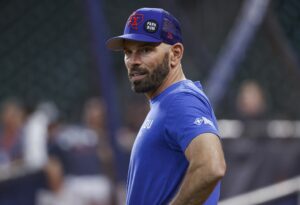Notre Dame High School, located in Sherman Oaks, California, is no stranger to the recruiting process. The attention and buzz surrounding the school’s MLB-level talent it tends to produce every few years is welcome. They’ve been there before, and they’re there once again. This time, it’s for an exciting 17-year-old, two-way player making a case to become the first right-handed high school pitcher to go first overall. The tools are there; he clocks in at 102 MPH and launches balls 450 feet on hard contact.
Hunter Greene 2017 MLB Draft Profile
A co-ed Catholic college preparatory high school, Notre Dame is responsible for the carnage Giancarlo Stanton has unleashed in Miami. The institution has also had a 1/1 pick in the past with Tim Foli. They don’t even know what they have in Hunter Greene, and same goes for just about everyone else. According to Lee Jenkins of Sports Illustrated, “Several scouts agree that he is the best two-way amateur prospect they have ever seen, a first-round pick as a pitcher and a shortstop.”
Just read about @HunterGreene17 in @SInow. Impressive kid. Your parents are special people.
Btw can you teach me Korean & how to throw 100?— Chris Archer (@ChrisArcher22) May 1, 2017
Hunter Greene the pitcher is most likely to appear at the draft. A team is would do well to give him a try on the mound for a while to see if he is the pitcher people believe him to be. If Greene fails his pitching trials, his career could be lengthened by stepping into the batter’s box. Every organization should be ready to call on Hunter Greene come June, as his strengths and pros far outweigh the weaknesses and cons.
Strengths
Greene’s most obvious strength is his versatility. He gives a team a high-upside pitcher with three average-or-better offerings. He’s also a valuable position player with quickness, unbelievable athleticism, great footwork, and an average-or-better grade at all five tools. It creates a problem for a team, further outlined in Lee Jenkins’ feature, where the franchise could choose to utilize both sides to Greene. This would come at the cost of his defense or innings available for the mound.
As a pitcher, Greene brings a plus-plus fastball consistently clocked in the triple digits. His 6’4, 200+ pound frame helps him bring the heat with ease, and will handle the abuses of pitching well. He’ll throw a slider and a curve that behave similarly. According to Hudson Belinsky of BaseballAmerica, “There are varying opinions in the scouting community on Greene’s breaking pitches, though most see his slider ahead of his curveball at this point. His slider projects as a plus pitch long term.” A potential MLB-average changeup is shown now and again, and Greene shows proficiency in his other offerings to the point that he needn’t rely in it much.
It’s official. Sherman Oaks Notre Dame wins Mission League baseball title after 13-2 win over St. Francis. Two home runs for Hunter Greene.
— eric sondheimer (@latsondheimer) May 9, 2017
As good as he’s been in shutting down opposing offenses on the mound, Hunter Greene has done just as well in creating offensive damage in the batter’s box. Plus-plus raw power with the bat comes from his size. He’s at least average in the field, as well as in speed and hitting. His 70-grade fastball works well when deep in the hole at shortstop, translating to a 60-grade arm on defense.
Weaknesses
Many prep arms struggle with command. The ability to feel their bodies through the motions and repeat their mechanics come with time. Hunter Greene is not an exception. While he pounds the zone with strikes, he struggles from time to time with repeating his delivery.
It’s not a worry right now, as most prep pitchers deal with this at the start of their careers. That’s what the minor leagues are for. With time will come muscle memory, and with that will come average or better command at the major league level.
The righty’s command has drawn accolades aplenty. Advanced for a prep arm, Greene has walked just four in 28 innings, while striking out 43. He’s logged 121.1 innings in his Notre Dame career, with a 1.62 ERA to show for it. The more advanced talent pool will expose just how well he can command his pitches. He won’t be able to rely on a hitter’s lack of understanding of the zone.
Hunter Greene gets much praise as a hitter as well, but has work to do. His 6’4 build serves him well in the power game; often in batting practice he displays the plus-plus raw power previously mentioned. Scouts don’t believe it will translate to the field. His power tool comes in at a 55 grade, often seen as a respectable teens-low twenties home run total. His power isn’t a weakness, it’s the translation to the field that hinders upside, adding to the belief he’s more a pitcher than hitter.
Being 6’4 and 200+ pounds at 17 years of age also raises some questions. If he continues to grow, does he outgrow the shortstop position? If that’s the case, he’ll likely slide over to third base or right field, where his arm strength plays well.
MLB Comparison
Pitcher
Scouts have pegged Greene for a Noah Syndergaard-type. He currently grades out exactly like Syndergaard’s teammate, Zack Wheeler.
Hitters and pitchers with comparable individual prospect grades to Hunter Greene’s ’17 grades from MLB@jimcallisMLBhttps://t.co/l8ZGpb3BQb pic.twitter.com/tDtGpoSfc5
— Jeff Zimmerman (@jeffwzimmerman) December 16, 2016
Position Player
Greene has been likened to Alex Rodriguez throughout the pre-draft fixation, and its foundation is hype. Greene will be a more consistent and athletic Jay Bruce.
Main Photo:






